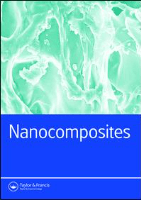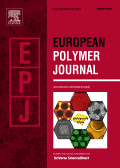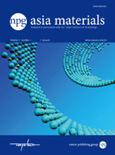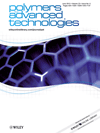
Nanocomposites
Scope & Guideline
Exploring the Future of Interdisciplinary Materials
Introduction
Aims and Scopes
- Nanocomposite Materials Development:
The journal emphasizes the synthesis and engineering of various nanocomposite materials, including polymers, ceramics, and metals, aimed at enhancing mechanical, thermal, and electrical properties. - Characterization Techniques:
A core focus on advanced characterization methods to analyze the structural, mechanical, and electrical properties of nanocomposites, ensuring the reliability and reproducibility of results. - Applications in Biomedical Engineering:
Significant attention is given to the application of nanocomposites in biomedical fields, such as drug delivery systems, wound healing materials, and tissue engineering, showcasing their potential for improving healthcare outcomes. - Environmental Applications:
Research on the use of nanocomposites for environmental remediation, including water treatment and pollutant degradation, highlights their role in addressing environmental challenges. - Innovative Manufacturing Techniques:
The journal explores cutting-edge manufacturing techniques for nanocomposites, including 3D printing and electrospinning, which are essential for practical applications in various industries.
Trending and Emerging
- Biocompatible Nanocomposites:
A rising trend is observed in the development of biocompatible nanocomposites for medical applications, particularly in tissue engineering and drug delivery systems, emphasizing the integration of nanotechnology in healthcare. - Sustainable and Green Nanocomposite Technologies:
There is an increasing focus on sustainable practices in nanocomposite synthesis, including green chemistry approaches and the use of biodegradable materials, aligning with global sustainability goals. - Advanced Electrical and Thermal Applications:
Emerging research is highlighting the use of nanocomposites in advanced electrical and thermal applications, such as sensors, energy storage devices, and electromagnetic interference shielding, showcasing their versatility. - Intelligent and Stimulus-Responsive Nanocomposites:
The development of intelligent nanocomposites that respond to external stimuli, such as temperature, pH, or light, is gaining traction, indicating a shift towards smart materials with adaptive functionalities. - Integration of AI and Machine Learning in Nanocomposite Research:
The application of artificial intelligence and machine learning techniques to optimize the design and performance of nanocomposites is emerging as a significant trend, enhancing predictive modeling and material discovery.
Declining or Waning
- Conventional Polymer Nanocomposites:
Research on traditional polymer nanocomposites, particularly those without innovative modifications or functionalities, has decreased as researchers pursue more complex and multifunctional materials. - Single-Component Nanoparticle Systems:
Studies focusing solely on single-component nanoparticle systems have waned, as the field has shifted towards hybrid and multi-component systems that offer enhanced properties and functionalities. - Basic Mechanical Property Studies:
There is a noticeable decline in publications centered exclusively on basic mechanical property assessments of nanocomposites, as the field moves towards more application-driven research.
Similar Journals

MATERIALE PLASTICE
Fostering Collaboration in Materials InnovationMATERIALE PLASTICE is a distinguished academic journal published by REVISTA CHIMIE SRL in Romania, focusing on the fields of Chemistry, Materials Science, and Engineering. With an ISSN of 0025-5289 and an E-ISSN of 2668-8220, this journal has a historical commitment to advancing the study of polymers and plastics since its inception in the early 1970s. Although classified in the Q4 category across multiple disciplines including miscellaneous chemistry and materials chemistry as of 2023, it serves as an important forum for researchers and professionals dedicated to innovative materials research and development. The journal’s resources, though not openly accessible, are pivotal for scholars seeking to deepen their knowledge in the mechanics of materials and interdisciplinary applications. MATERIALE PLASTICE is not only a repository of significant research findings but also a platform for fostering collaboration and discussion among a global audience that continues to strive for scientific excellence in polymer and materials studies.

Nano Research
Connecting researchers to the world of nanoscale innovation.Nano Research, published by TSINGHUA UNIVERSITY PRESS, is a prestigious academic journal dedicated to advancing the fields of nanoscience and nanotechnology. Since its inception in 2009, the journal has established itself as a leading platform for the dissemination of high-quality research, evidenced by its impressive Q1 rankings across multiple categories including Atomic and Molecular Physics, Condensed Matter Physics, and Electrical and Electronic Engineering. With an impact that resonates globally, Nano Research not only attracts contributions from renowned researchers but also appeals to students and professionals striving to stay at the forefront of innovation. The journal’s commitment to excellence is reflected in its ranking, placing it in the top echelons of its field, as evidenced by its notable Scopus standings. Researchers can benefit from its rigorous peer-review process and broad scope, encompassing theoretical, experimental, and applied studies. For those passionate about pushing the boundaries of knowledge in the realm of nanotechnology, Nano Research serves as an indispensable resource.

DESIGNED MONOMERS AND POLYMERS
Exploring the frontiers of monomer and polymer design.Designed Monomers and Polymers is a prestigious open-access journal published by Taylor & Francis Ltd, dedicated to advancing the field of chemical and material sciences. Since its inception in 1998, the journal has provided a vital platform for disseminating innovative research on the synthesis and applications of monomers and polymers. With a current impact factor reflecting its growing relevance, it falls within the Q3 category across multiple domains, including Chemical Engineering, Chemistry, and Materials Science, making it a valuable resource for researchers and professionals seeking to stay at the forefront of material innovation. Operating from the United Kingdom, the journal emphasizes accessibility, having adopted an Open Access model since 2016, allowing wider distribution and utilization of its published content. Researchers, students, and industry professionals are encouraged to explore its comprehensive articles that contribute to the ongoing dialogue in polymer science, fostering advancements that can lead to real-world applications and technological progression.

EUROPEAN POLYMER JOURNAL
Leading the Charge in Polymer Knowledge and InnovationEUROPEAN POLYMER JOURNAL is a leading academic journal published by PERGAMON-ELSEVIER SCIENCE LTD, dedicated to advancing the field of polymer science and engineering. With a distinguished history since 1965, this journal serves as a critical platform for researchers to disseminate high-quality research findings within a broad scope that encompasses materials chemistry, organic chemistry, and physics. The journal boasts an impressive Q1 category ranking in multiple fields, including Materials Chemistry, Organic Chemistry, and Polymers and Plastics, placing it in the top tier of academic journals worldwide. Its standing is further reinforced by its high citation metrics, with ranks such as #16 in Organic Chemistry and #20 in Polymers and Plastics, reflecting its significant contribution to the advancement of knowledge and innovation in these areas. Although currently not available as an open-access journal, it provides subscribers with in-depth studies, reviews, and insights relevant to both academia and industry. Researchers, professionals, and students alike will find invaluable information and emerging trends in polymer research, making the EUROPEAN POLYMER JOURNAL an essential resource for staying at the forefront of this dynamic and evolving field.

MACROMOLECULAR RESEARCH
Unlocking the Potential of Polymers WorldwideMACROMOLECULAR RESEARCH, published by the POLYMER SOC KOREA, is a premier journal dedicated to advancing the field of macromolecular science and polymer engineering. With its ISSN 1598-5032 and E-ISSN 2092-7673, this journal has emerged as a vital platform for researchers and professionals interested in the application and development of polymers across various domains. Based in South Korea and operating as an open-access resource since its inception in 2002, MACROMOLECULAR RESEARCH consistently ranks in the Q2 category across diverse fields such as Chemical Engineering, Materials Chemistry, and Organic Chemistry as per the latest 2023 metrics. Notably, it is recognized for its substantial contributions to polymery science, increasing its visibility and impact in global research. By providing a forum for original research articles, reviews, and innovative methodologies, this journal aims to foster collaboration and knowledge sharing among scientists, engineers, and students alike. Join a community that is at the forefront of polymer research by exploring the wealth of resources and cutting-edge studies featured in MACROMOLECULAR RESEARCH.

NPG Asia Materials
Elevating the Discourse on Material Properties and InnovationsNPG Asia Materials, a premier journal published by NATURE PORTFOLIO, stands at the forefront of research in the fields of condensed matter physics, materials science, and modeling and simulation. With an impressive Impact Factor gracing its Q1 rankings in 2023, this open-access journal, established in 2012, offers a vital platform for disseminating high-quality research articles, reviews, and perspectives that advance the understanding of material properties and innovative applications. Based in the United States and catering to a global audience, NPG Asia Materials features cutting-edge contributions that not only enhance academic scholarship but also provoke discussions relevant to both industry and academia. Researchers, professionals, and students are invited to explore its extensive archive of work, covering insights from 2009 to 2024, in a bid to stay abreast of the latest developments in these rapidly evolving scientific domains.

Polymers
Unveiling the potential of polymers for industrial progress.Polymers is a premier journal published by MDPI, dedicated to advancing the field of polymer science and technology. This open-access journal, established in 2009, has quickly gained prominence in the academic community, serving as a vital platform for disseminating high-quality research articles, reviews, and communications in the realms of chemistry, polymers, and plastics. Based in Switzerland, with an impressive ranking in the Q1 quartile for both Chemistry and Polymer studies, Polymers boasts a significant impact factor, reflecting its rigorous peer-review process and esteemed editorial board. Researchers, professionals, and students alike benefit from the broad accessibility of content, allowing for a more extensive reach and engagement within the scientific community. As a key resource for the latest advancements and innovations in polymer research, Polymers continues to lead discussions, inspire collaborations, and foster the development of novel materials that shape various industrial applications.

BIOPOLYMERS
Advancing the Science of BiopolymersBIOPOLYMERS, a distinguished journal founded in 1963 and published by WILEY, serves as an essential platform for the dissemination of research in the fields of biochemistry, biomaterials, biophysics, and organic chemistry. With an ISSN of 0006-3525 and E-ISSN 1097-0282, this journal has been pivotal in advancing our understanding of the intricate roles that biopolymers play in various biological systems and their applications in medicine and technology. The journal is recognized for its rigorous peer-review process and has established itself within the academic community, boasting impressive Scopus rankings across multiple disciplines, including a Q2 ranking in both Biophysics and Medicine for 2023. Although it does not offer Open Access options, BIOPOLYMERS provides invaluable access to critical insights and developments in the study of biopolymers, appealing to researchers, professionals, and students dedicated to innovating in this dynamic field.

POLYMERS FOR ADVANCED TECHNOLOGIES
Transforming Ideas into Advanced Polymer SolutionsPOLYMERS FOR ADVANCED TECHNOLOGIES is a premier peer-reviewed journal published by WILEY, focusing on cutting-edge research in the field of polymers and plastics. Since its inception in 1990, the journal has established itself as a critical resource for academics and industry professionals alike, reflecting advancements and innovations in polymer science and technology. With an impressive Scopus ranking of #45 out of 161 in the Materials Science category and a 72nd percentile ranking, it ranks in the Q2 quartile for its relevance and impact within the polymers field. The journal's comprehensive scope encompasses recent developments and trends in polymer applications, synthesis, and characterization, making it essential reading for researchers looking to advance their work within this dynamic area. Researchers can submit their work in the UK, where the journal is published, and while it does not currently offer open-access options, its robust impact factor highlights the significance of the research it disseminates. Join the community of experts pushing the boundaries of polymer science by engaging with POLYMERS FOR ADVANCED TECHNOLOGIES. Continuous exploration and innovation await those who contribute to and learn from the journal’s diverse array of studies.

Express Polymer Letters
Catalyzing Collaboration in Material ChemistryExpress Polymer Letters is a leading open-access journal published by BUDAPEST UNIVERSITY OF TECHNOLOGY AND ECONOMICS, focusing on the fast-paced realm of polymer science and engineering. With a broad scope that encompasses the interdisciplinary fields of Chemical Engineering, Materials Chemistry, and Organic Chemistry, the journal serves as a crucial platform for researchers and professionals dedicated to advancing knowledge and innovation in polymer-related disciplines. Since its inception in 2007, it has consistently provided high-quality, peer-reviewed research and has achieved a respectable impact within various categories, evidenced by its Q2 quartile rankings across multiple Scopus categories and its competitive standings in the field. The journal's dedication to open access ensures that research is widely disseminated, promoting transparency and collaboration within the academic community. Positioned to converge into the future, Express Polymer Letters remains an essential resource for cutting-edge studies and developments, with an anticipated convergence period extending through 2024.